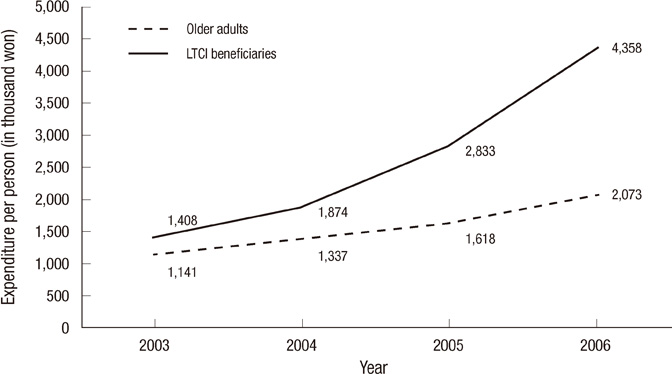J Korean Med Sci.
2012 May;27(Suppl):S41-S46. 10.3346/jkms.2012.27.S.S41.
Role of Healthcare in Korean Long-Term Care Insurance
- Affiliations
-
- 1Department of Nursing, College of Health Industry, Youngdong University, Youngdong, Korea.
- 2Institute of Health Services Research, Yonsei University, Seoul, Korea.
- 3Department of Preventive Medicine and Public Health, Ajou University School of Medicine, Suwon, Korea. yhlee@ajou.ac.kr
- 4Institute on Aging, Ajou University Medical Center, Suwon, Korea.
- KMID: 1714487
- DOI: http://doi.org/10.3346/jkms.2012.27.S.S41
Abstract
- With the rapid aging of the population, Korea introduced public long-term care insurance for older people in 2008. The long-term care insurance was designed as a separate scheme from the national health insurance, with eligibility qualifications and the certification process based on functional disability, benefits and coverage of community-based and institutional care, and a financing structure through multi-party contributions. Delivering appropriate health services to long-term care beneficiaries who manifest a high prevalence of comorbid chronic conditions with rising healthcare costs, however, presents a particular challenge. The lack of coordination between the health and long-term care sectors, limited consideration of physicians' assessments in the certification process, inadequate provision of health services in long-term care facilities, and overlapping and inefficient use of care resources act as barriers to providing comprehensive healthcare for older beneficiaries. Through active participation in the long-term care system, health professionals can help older patients navigate through the complex long-term care terrain to obtain quality healthcare.
Keyword
MeSH Terms
Figure
Cited by 2 articles
-
Association between Timed Up and Go Test and Subsequent Functional Dependency
Ji Eun Lee, Hyejin Chun, Young-Sang Kim, Hee-Won Jung, Il-Young Jang, Hyun-Min Cha, Ki Young Son, Belong Cho, In Soon Kwon, Jong Lull Yoon
J Korean Med Sci. 2020;35(3):. doi: 10.3346/jkms.2020.35.e25.Predictors of Institutionalization in Patients with Alzheimer's Disease in South Korea
Dong-Gyu Park, Soojin Lee, Young Min Moon, Duk L. Na, Ji Hyang Jeong, Kyung Won Park, Yoon Hwan Lee, Tae Sung Lim, Seong Hye Choi, So Young Moon
J Clin Neurol. 2018;14(2):191-199. doi: 10.3988/jcn.2018.14.2.191.
Reference
-
1. The population projections for Korea. Korea Statistics Office, Korean Statistical Information Service. accessed on 8 February 2011. Available at http://kosis.kr/abroad/abroad_02List.jsp.2. Kwon S. Future of long-term care financing for the elderly in Korea. J Aging Soc Policy. 2008. 20:119–136.3. Neumann PJ, Araki SS, Gutterman EM. The use of proxy respondents in studies of older adults: lessons, challenges, and opportunities. J Am Geriatr Soc. 2000. 48:1646–1654.4. Ministry of Health and Welfare, National Health Insurance Corporation. The collection of long-term care insurance laws. 2008. Seoul: Ministry of Health and Welfare, National Health Insurance Corporation.5. The long-term care assessment instrument form. National Health Insurance Corporation. accessed on 8 February 2011. Available at http://www.longtermcare.or.kr/portal/site/nydev/MENUITEM_PD1/.6. National Health Insurance Corporation. 2009 Long-term care insurance statistical yearbook. 2010. Seoul: National Health Insurance Corporation.7. Kang IO. Integration of healthcare and long-term care. Symposium Proceedings of the Korean Society for Preventive Medicine. 2010.8. Kang IO, Park CY, Kwon JH, Kim KH. Utilization of services by long-term care insurance beneficiaries and cohort design. 2007. Seoul: National Health Insurance Corporation.9. Kang IO, You CH, Han EJ, Lee JS. Comparison between healthcare expenditure of long-term care insurance beneficiaries and the general older population. The Korean Gerontological Society Proceedings. 2008.10. Yu SH, Lee Y. Public health and aging. 2007. Seoul: Gyechuk Munhwasa.11. Guralnik JM, Fried LP, Salive ME. Disability as a public health outcome in the aging population. Annu Rev Public Health. 1996. 17:25–46.12. Defever M. Long term care: the case of the elderly. Health Policy. 1991. 19:1–18.13. Park CY. Consideration about healthcare in long-term care insurance. Report from the Research on Aging Forum. 2008. Seoul: Federation of Korean Gerontological Societies.14. Roh YK, Sunwoo D, Yoon JL. Defining the role of long-term care facilities and geriatric hospitals. 2010. Seoul: Ministry of Health and Welfare, Korean Geriatrics Society.15. Kim HS, Lee SH, Lee HJ. Setting the eligibility criteria of health insurance with the implementation of the long-term care insurance. 2008. Seoul: National Health Insurance Corporation, Daegu Haany University, Korea Health Industry Development Institute.16. The Committee of Future Strategy for Health Security. Future strategies for health security. Seoul: The Committee of Future Strategy for Health Security.17. Park CY, Lee Y, Kwon JH, Lee EM, Lee HY, Kim YH. Developing an integrated care model for long-term and healthcare. 2010. Seoul: National Health Insurance Corporation.
- Full Text Links
- Actions
-
Cited
- CITED
-
- Close
- Share
- Similar articles
-
- Korean Elderly Long-term Care Insurance System and Long-term Care Hospital
- The Long-term Care Management for the Elderly in Korea
- Long-Term Care Insurance and Medical Services for the Elderly: The Role of the Healthcare Industry
- Community-Based Home Healthcare Project for Korean Older Adults
- Care Grading System and the Professional Role of Long-term Care Insurance


